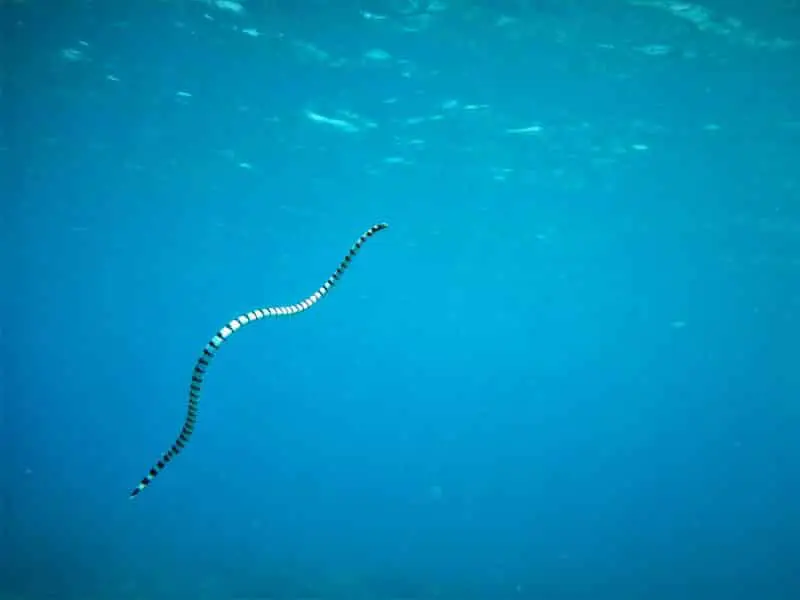Embark on an underwater adventure as we dive into the fascinating world of learning about sea snakes! These elusive and stunning creatures, often mistaken for eels, add an extra layer of mystery to the ocean depths. Thriving in warmer waters and predominantly found in tropical havens, spotting a sea snake in the wild is a rare and exciting encounter. Join us on a comprehensive journey with our guide to sea snakes, unraveling the secrets of these remarkable serpentine swimmers. You might also like to see the Worlds Largest Anaconda.
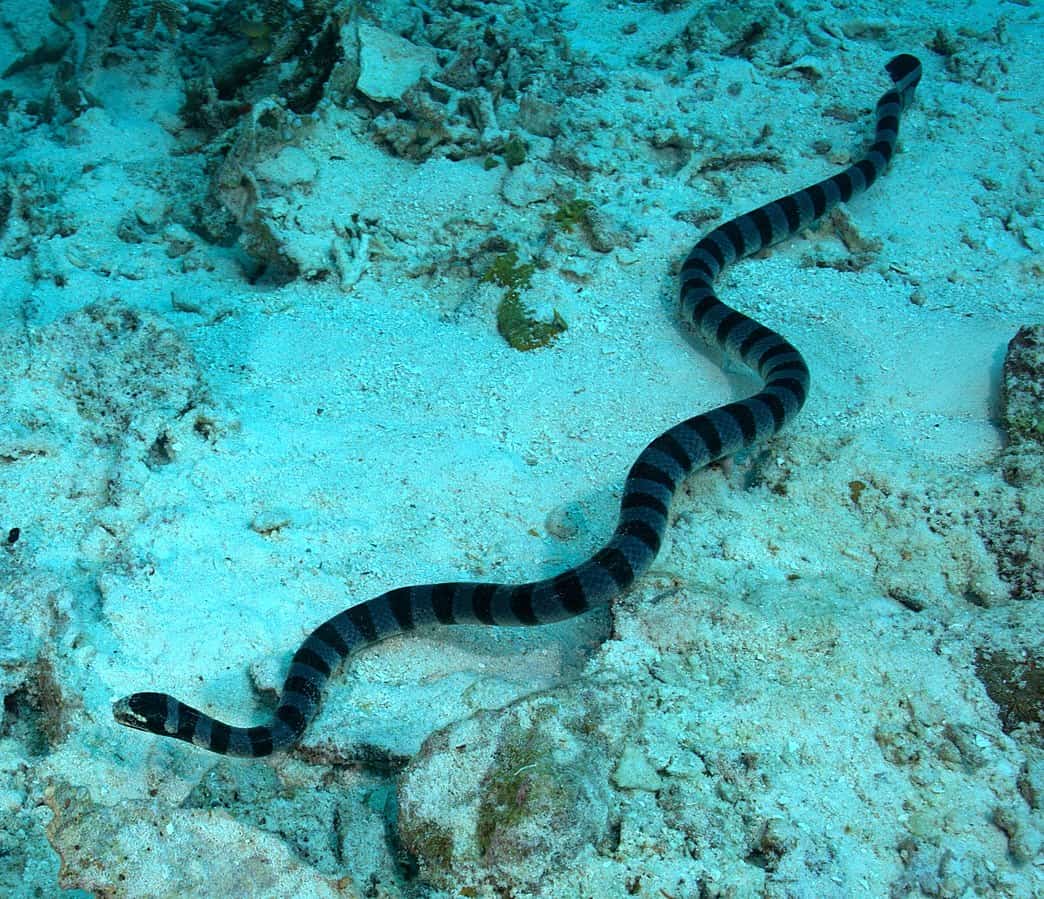
This blog will touch on the lives of these little sea snakes; use the headings below to guide you through the blog article:
What are Sea Snakes
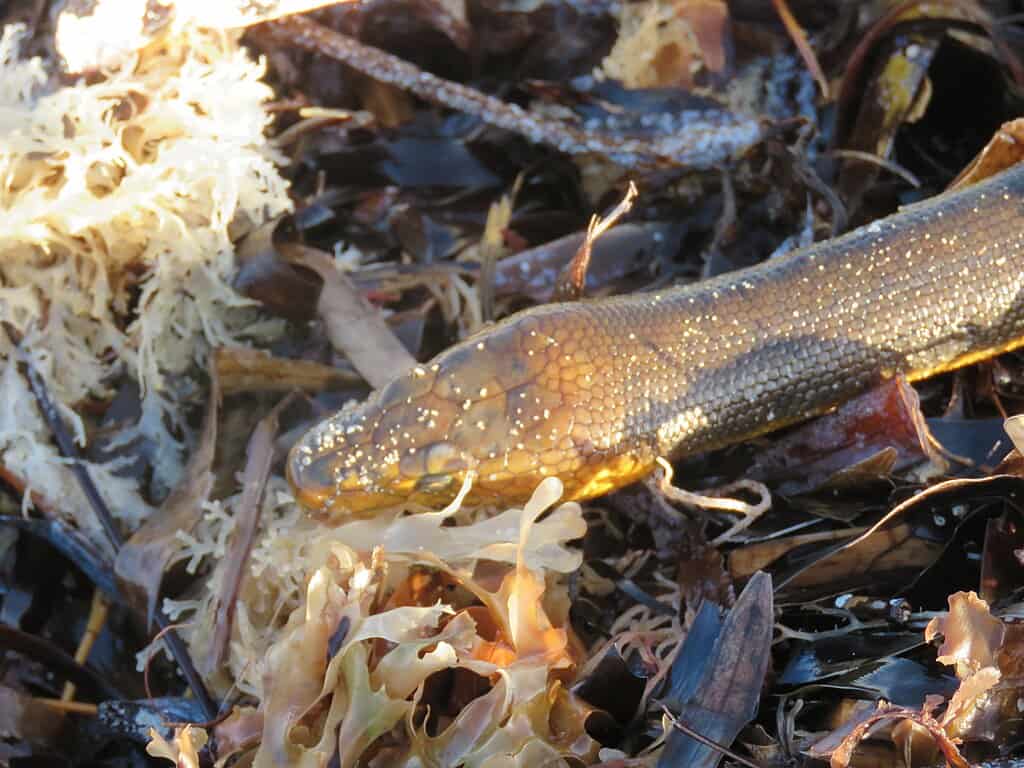
Yellow sea snakes are air breathing reptiles and must come to the surface to breathe. Image via Calistemon, CC BY-SA 4.0 https://creativecommons.org/licenses/by-sa/4.0, via Wikimedia Commons
In the vast expanse of the ocean, sea snakes emerge as intriguing inhabitants, encompassing around 60 highly venomous species within the cobra family (Elapidae). This unique group comprises two distinct evolutionary branches: the actual sea snakes (subfamily Hydrophiinae), kin to Australian terrestrial elapids, and the sea kraits (subfamily Laticaudinae), relatives of the Asian cobras. Despite wielding potent venom, encounters with these serpentine creatures seldom result in harm to humans due to their non-aggressive nature, limited venom output, and short fangs.
Among the 55 species of actual sea snakes, adults typically measure 1–1.5 meters, with exceptional individuals reaching lengths of 2.7 meters. Adapted to marine life, sea snakes feature a flattened body, a short oarlike tail, valvular nostrils atop their snout, and elongated lungs extending the entire body. Their scales, arranged like paving stones, are small and usually non-overlapping. While these species retain reduced belly scales, advanced forms lack them, rendering them incapable of crawling on land. The keel formed during swimming enhances surface area, aiding propulsion through lateral undulation.
Remarkably, sea snakes showcase the ability to remain submerged for extended periods, potentially up to eight hours, facilitated by skin respiration. Cutaneous respiration enables them to transport over 90 percent of waste carbon dioxide and 33 percent of their oxygen requirement directly through their skin. A 2019 study of the blue-banded sea snake revealed a highly vascularized area between the snout and the head, allowing oxygen to reach the brain directly from the water. These fascinating creatures give birth in the ocean, delivering an average of 2–9 offspring, with some instances of up to 34 young.
On the other hand, the six species of sea kraits exhibit a less specialized aquatic lifestyle. While possessing a flattened tail, their cylindrical bodies and lateral nostrils set them apart. Sea kraits, adorned with alternating black and gray, blue, or white rings, demonstrate a distinctive color pattern. The yellow-lipped sea krait, a common species, showcases this pattern along with a yellow snout. Nocturnal hunters, sea kraits primarily feed on eels at depths less than 15 meters, venturing ashore to lay eggs in limestone caves or rock crevices. With the ability to crawl and climb on land, sea kraits deposit 1–10 eggs and have an average adult length of 1 meter, although some individuals exceed 1.5 meters. In captivity, sea kraits can live up to seven years, adding to the wealth of information in this Sea Snakes: A Complete Guide.
About Sea Snake
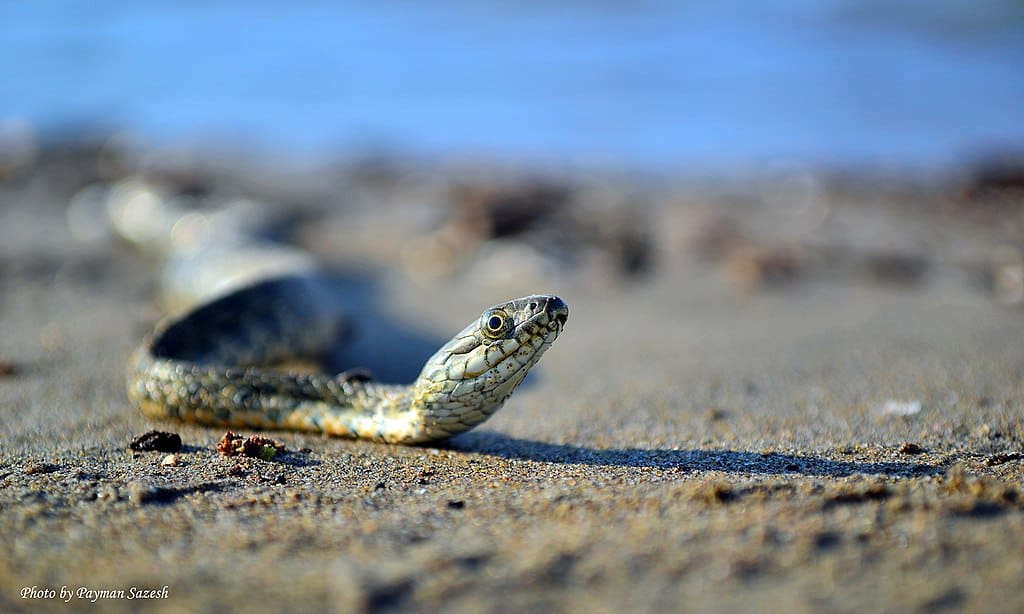
Sea snakes are front-fanged and highly venomous.
Concealed within a fold of gums, the fangs of a sea snake are strategically hidden, swiftly emerging when engaged in biting. Despite their seemingly delicate nature, these fangs, prone to breakage, pose a unique challenge as they may remain lodged in the wounds of their victims. To compensate for this vulnerability, sea snakes boast potent venom, a formidable substance that efficiently paralyzes, kills, and initiates the digestive process upon contact with the fish they target.
Originating from distinct snake lineages—the cobra in Asia and Australian terrestrial elapids—sea snakes have evolved to become viviparous. This means they give birth to fully-formed young at sea, bypassing the conventional egg-laying process. Notably, sea snakes have a critical dependence on fresh water for drinking, and their survival at sea hinges on access to this essential resource. Deprived of fresh water, sea snakes risk dehydration, underscoring the delicate balance these fascinating marine creatures maintain in their underwater realms.
Where do Sea Snakes live?
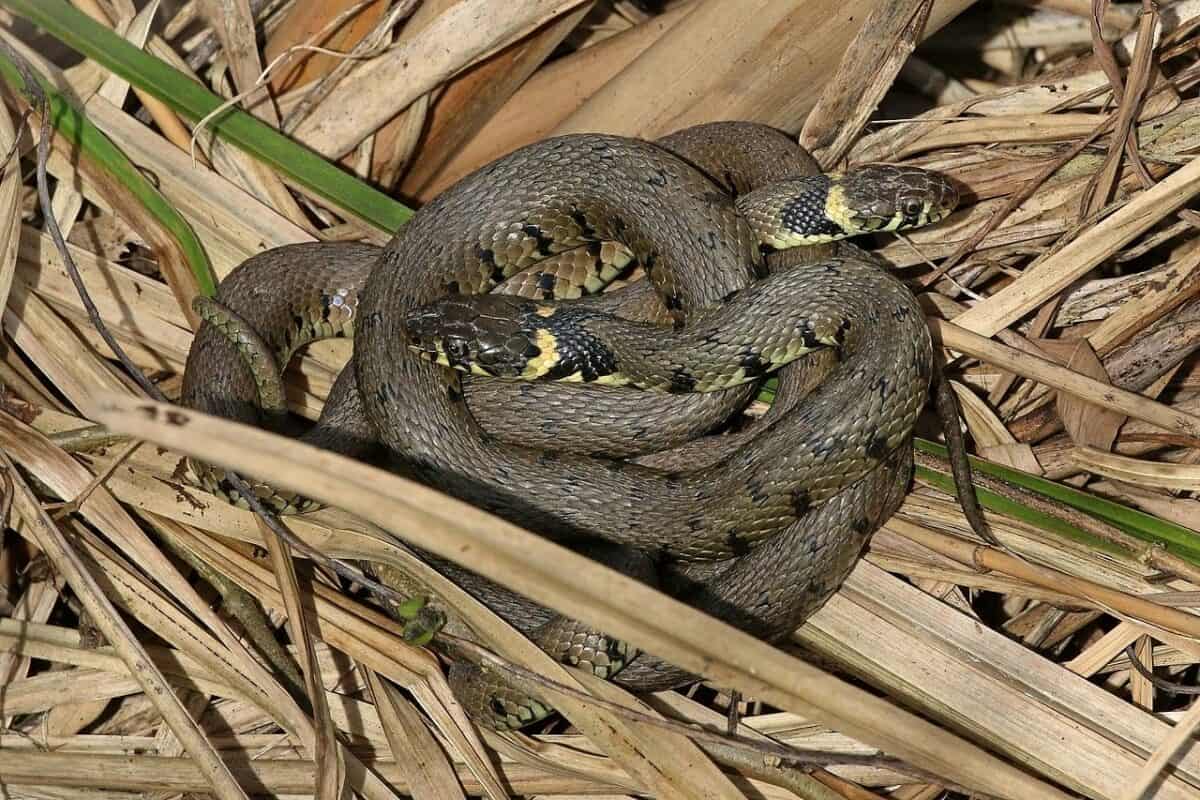
Image of a grass snake. Image via Charles J. Sharp, CC BY-SA 4.0 https://creativecommons.org/licenses/by-sa/4.0, via Wikimedia Commons
Confined to the coastal regions of the Indian and Western Pacific oceans, sea snakes inhabit waters stretching from the east coast of Africa to the Gulf of Panama. The exception is the yellow-bellied sea snake, which ventures into the open ocean, spanning from Africa eastward across the Pacific to the west coast of the Americas. This comprehensive guide to sea snakes is crafted to shed light on their diverse habitats and behaviors.
These marine reptiles predominantly reside in waters less than 30 meters (approximately 100 feet) deep, necessitating dives to the seafloor for foraging expeditions among coral reefs, mangroves, or the ocean bottom. With distinct preferences, some species favor hard bottoms, such as coral formations, while others opt for soft bottoms like mud or sand to pursue their prey.
Sea snakes exhibit a varied diet, predominantly feasting on fishes of diverse sizes and shapes, including eels. Notably, certain groups, represented by the genera Aipysurus and Emydocephalus, exclusively consume fish eggs. In contrast, the Hydrophis genus specializes in hunting burrowing eels, highlighting the adaptability and specialized feeding strategies of these intriguing marine creatures.
About Sea Snakes & Bites
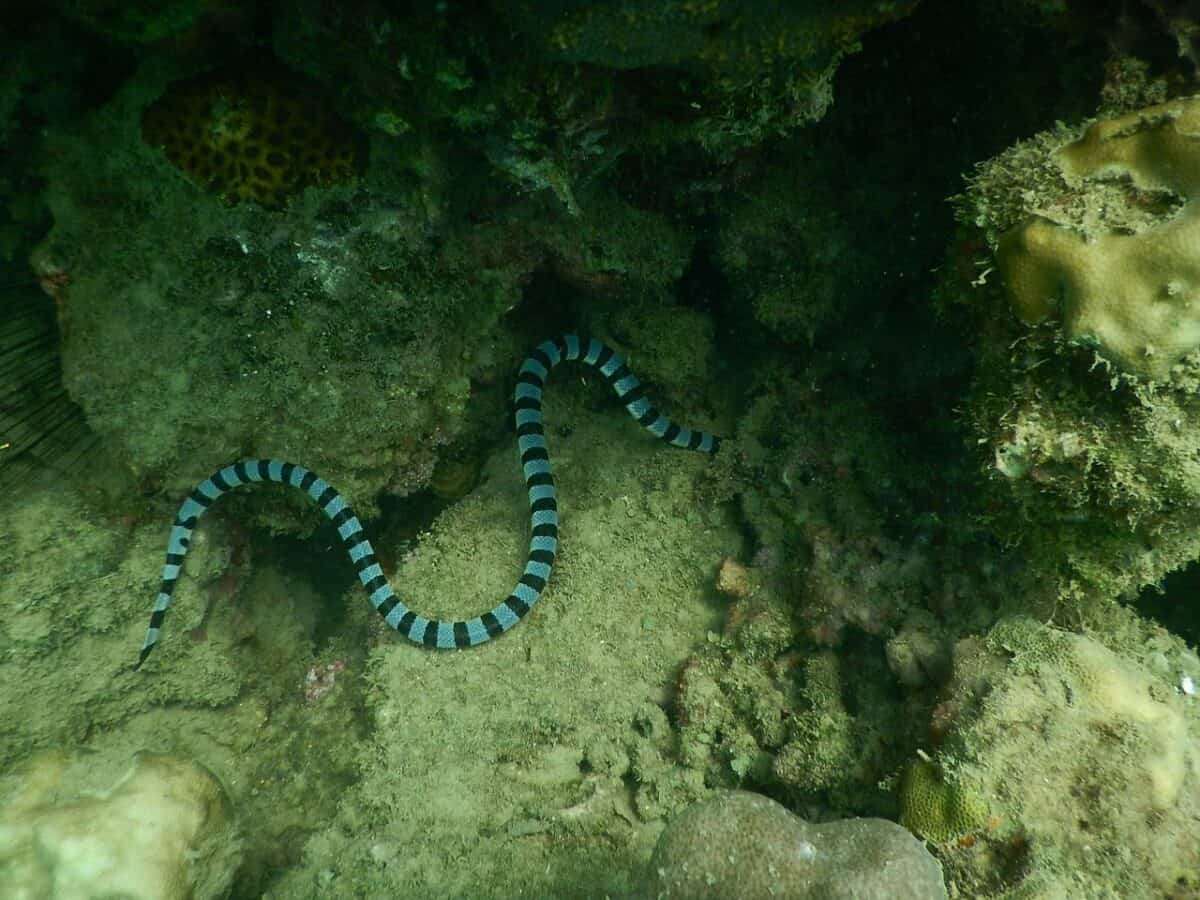
A sea snake bite poses a potential threat, occasionally resulting in fatalities in the Western Central Pacific. Common victims include fishermen engaged in handling gape nets, sorting fish on a trawler, or wading in muddy coastal waters or river mouths while dragging a net. While some sea snakes are known for their gentle and non-aggressive nature, only resorting to biting when provoked, others exhibit a more confrontational demeanor.
Despite the fact that sea snakes typically inject minimal venom, often leading to no or only minor symptoms of poisoning, it is imperative to approach all sea snakes with caution, as outlined in this comprehensive Sea Snakes: A Complete Guide.
In the event of a snake bite, the following first-aid measures are recommended:
- Limbs (arm or leg) Bite:
- Immediately wrap a broad crepe bandage or a similar material around the bite area.
- Ensure the bandage is tight and extends over the entire arm or leg.
- Utilize a splint to immobilize the affected limb.
- Seek hospital treatment promptly.
- Body Bite:
- Firmly press the area of the bite.
- Seek hospital treatment without delay.
These first-aid procedures are essential for mitigating the effects of a sea snake bite and seeking timely medical assistance for a swift and appropriate response.
About Sea Snakes: Ecology and Conservation
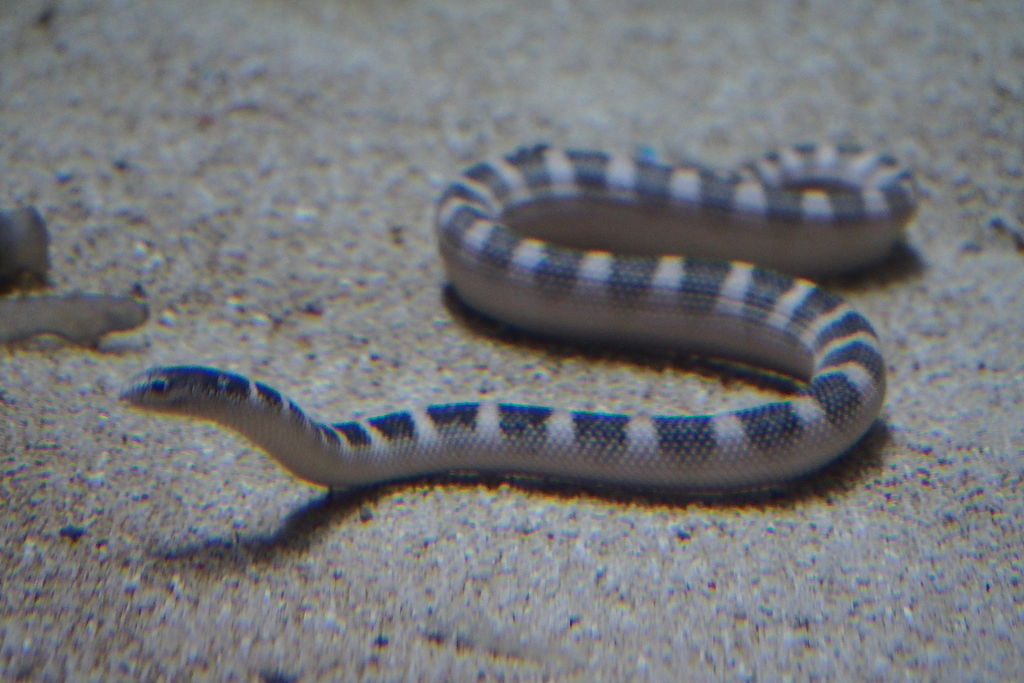
Sea snakes face exploitation for their skin, organs, and meat, with certain species being heavily targeted. Surprisingly, these creatures are not safeguarded by CITES, the Washington Convention. The commercial use of sea snake meat and skin dates back to 1934 in the Philippines, raising concerns about potential overexploitation. Recognizing this, local protection measures have become crucial.
Australia, Japan, Taiwan Province of China, Thailand, and Vietnam also contribute to the exploitation of sea snakes. Queensland, Australia, has implemented a special license for sea snake collection. Unfortunately, most sea snake fisheries in the Indian and Pacific oceans remain undocumented in the literature, escaping governmental control—hence the need for this comprehensive Sea Snakes: A Complete Guide.
Apart from the Philippines, the impact of exploitation on sea snake populations is largely unknown, raising concerns about potential endangerment. To ensure sustainable yields and enable timely intervention by local governments, monitoring and controlling commercial catches are essential.
Managing sea snake fisheries and protecting endangered species requires a fundamental understanding of the group and the ability to identify species accurately. Despite numerous sea snake species existing in the Indian and Pacific oceans, their absence in the Atlantic and Caribbean remains a noteworthy phenomenon, prompting further exploration.
Ocean Current and Climate Barriers
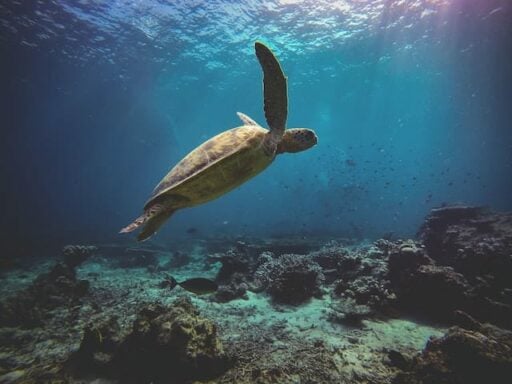
About sea snakes diverse lifestyles; with some, known as sea kraits, capable of living on both land and in water, laying their eggs on land. This unique characteristic limits their range, necessitating proximity to land for reproductive purposes. On the other hand, fully marine sea snakes are viviparous, giving birth to fully-formed young at sea without laying eggs. This adaptation enabled the yellow-bellied sea snake to extend its range across the Indo-Pacific, ultimately reaching the Pacific coast of Central America.
The formation of the Isthmus of Panama separated the Pacific and Atlantic oceans, restricting the sea snake’s movement. Although the Panama Canal’s opening in 1914 provided occasional access to Caribbean waters, the species tends to drift with currents, making it unlikely to establish a breeding population in the east. Since the canal’s completion, no sea snake population has been established on the eastern side.
While the possibility of sea snakes entering the Atlantic Ocean by swimming from the Indian Ocean exists, two significant obstacles impede their westward travel. The cold Benguela Current, west of the Cape of Good Hope, brings icy water to the coast of southwestern Africa, unsuitable for sea snake survival. Additionally, sea snakes require fresh water for drinking, and the arid climate of coastal southwest Africa offers minimal rainfall, hindering the formation of the freshwater lenses they depend on. This Sea Snakes: A Complete Guide delves into the intricacies of their habitats and behaviors.
Evolving from land to sea
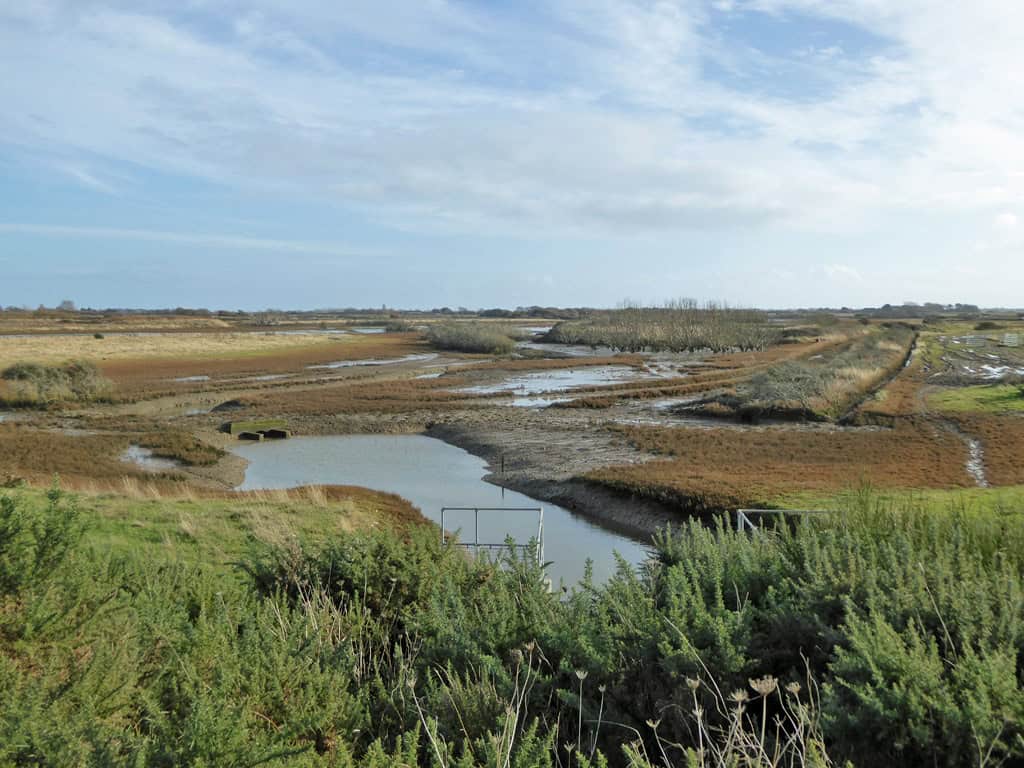
The potential for sea snakes to establish themselves in the Caribbean arises from the evolutionary transitions that certain snake families, such as elapids, have made from terrestrial or freshwater habitats to marine environments. In the Coral Triangle region, a hotspot for biodiversity located in Southeast Asia, elapid snakes, including sea snakes, have undergone such transitions.
Most present-day sea snake species originated and diversified in the Coral Triangle between 2 to 16 million years ago. During this period, the region was characterized by extensive wetlands associated with Southeast Asia and the Australasian archipelago. The Coral Triangle, featuring interwoven land and sea elements, has a history of fluctuating sea levels, creating marine corridors and shaping stable, shallow habitats like mangrove fringes and mud flats.
These environmental conditions in the Coral Triangle have been conducive to evolutionary shifts from land to sea, resulting in the persistence of stable, shallow marine habitats for the past 3 million years. Although similar environmental changes occurred in the Caribbean, the Coral Triangle’s larger size and greater complexity have facilitated multiple ancestral lineages of snakes, leading to a higher diversity of viviparous (live-bearing) estuarine species in the Coral Triangle compared to the Caribbean. This Sea Snakes: A Complete Guide explores the intricate evolutionary processes that have shaped sea snake distribution.
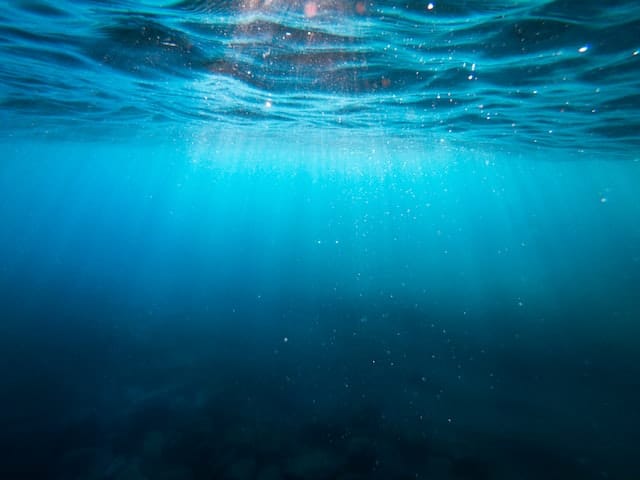
The prospect of sea snakes dispersing from the Indo-Pacific to the Atlantic Ocean in the future remains unlikely due to existing oceanic and weather conditions. Unlike the occasional appearance of drifted sea snakes on California beaches, it is not anticipated that sea snakes will emerge on Florida beaches, primarily due to the absence of a viable source for such occurrences.
Current indications suggest that certain populations and species of sea snakes are experiencing declines or facing extinction, attributed to factors such as shifts in rainfall patterns, water temperatures, environmental contamination, and human exploitation. As climate change continues to unfold, future climatic variations may bring both negative and positive impacts on the biogeography of sea snakes. This Sea Snakes: A Complete Guide delves into the complex dynamics influencing the distribution and survival of sea snake populations.
Summary of Sea Snakes
It can be said that seeing a snake in the wild is exceptionally special and rare. Tour groups are not necessarily available to see only sea snakes; however, in some cases spotting a sea snake may be a by-product of another tour in the tropical regions in which they reside.
If you enjoyed reading this blog article, visit our other blogs about our reptiles and alligators.
Join our Forum for free today!

- Third Elk Incident in Two Weeks in Estes Park, Colorado and How to Stay Safe - July 4, 2024
- 17 Animals That Mate For Life - June 24, 2024
- 13 Animals That Lay Eggs (Some Might Surprise You!) - June 16, 2024

